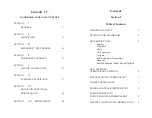
Sinus 912 LSA Glider 550 MTOW
www.pipistrel.eu
REV. 3
Normal procedures
Initial climb
When airborne, engage brakes momentarily to prevent in-flight wheel spinning.
Accelerate at full power and later maintain proper climbing speed.
As you reach 50 kts (90 km/h) at above 150 ft (50 m), set flaps to 1
st
stage, reaching 60 kts (110 km/h)
at 300 ft (100 m) set flaps to neutral position. Reduce RPM by 10% or below 5500 RPM and continue
climbing at 70 kts (130 km/h).
Adjust the trim to neutralize the stick force if necessary.
Remember to keep the temperatures and RPM within operational limits during climb out.
CAUTION!
Reduce power and lower the nose to increase speed in order to cool the engine
down if necessary.
Should you be climbing for a cross-country flight, consider climbing at 100 kts (185 km/h) as this will
greatly increase your overall travelling speed.
Reaching cruise altitude, establish horizontal flight and set engine power to cruise (5300 RPM).
Cruise
When horizontal flight has been established, verify on-board fuel quantity again.
Keep the aircraft balanced while maintaining desired flight parameters.
Should you desire to cruise at low speed (up to 80 kts
(150 km/h)
), set flaps to neutral position other-
wise flaps should be set to negative position (flap handle full down).
Check engine operation and flight parameters regularly! Recommended cruise is at 5300 RPM, with a
fuel burn of 3.3 US gal per hour.
CAUTION!
It is not recommended to fly the aircraft at speeds exceeding 80 kts
(150 km/h)
using
flap setting other than negative.
Flying in cruise, check fuel levels as well. Because of the fuel system design, the fuel tends to gradu-
ally cross-flow from the right tank to the left. To prevent this, shut the right fuel valve and open it
again when the fuel level inside left tank has lowered.
CAUTION!
If the fuel quantity in a fuel tank is low, it is possible that the engine starts to suck
air into the fuel system. To prevent this and consequent engine failure, always close the fuel valve
of the tank where the fuel quantity is very low.
Cruising in rough conditions
Should you experience turbulence, reduce airspeed and continue flying with flaps set to neutral po-
sition.
CAUTION!
In rough air, reduce engine power if necessary to keep airspeed below VRA.
4-8
Содержание Sinus 912 LSA LSA-GLIDER
Страница 2: ...Sinus 912 LSA Glider 550 MTOW www pipistrel eu REV 3 This page is intentionally left blank i 1 ...
Страница 8: ...Sinus 912 LSA Glider 550 MTOW www pipistrel eu REV 3 This page is intentionally left blank i 7 ...
Страница 10: ...Sinus 912 LSA Glider 550 MTOW www pipistrel eu REV 3 This page is intentionally left blank 0 2 ...
Страница 13: ...Sinus 912 LSA Glider 550 MTOW www pipistrel eu REV 3 3 view drawing General 1 3 ...
Страница 30: ...Sinus 912 LSA Glider 550 MTOW www pipistrel eu REV 3 This page is intentionally left blank 3 6 ...
Страница 52: ...Sinus 912 LSA Glider 550 MTOW www pipistrel eu REV 3 This page is intentionally left blank 6 6 ...
Страница 92: ...Sinus 912 LSA Glider 550 MTOW www pipistrel eu REV 3 This page is intentionally left blank 9 20 ...
Страница 100: ...Sinus 912 LSA Glider 550 MTOW www pipistrel eu REV 3 This page is intentionally left blank ...
















































